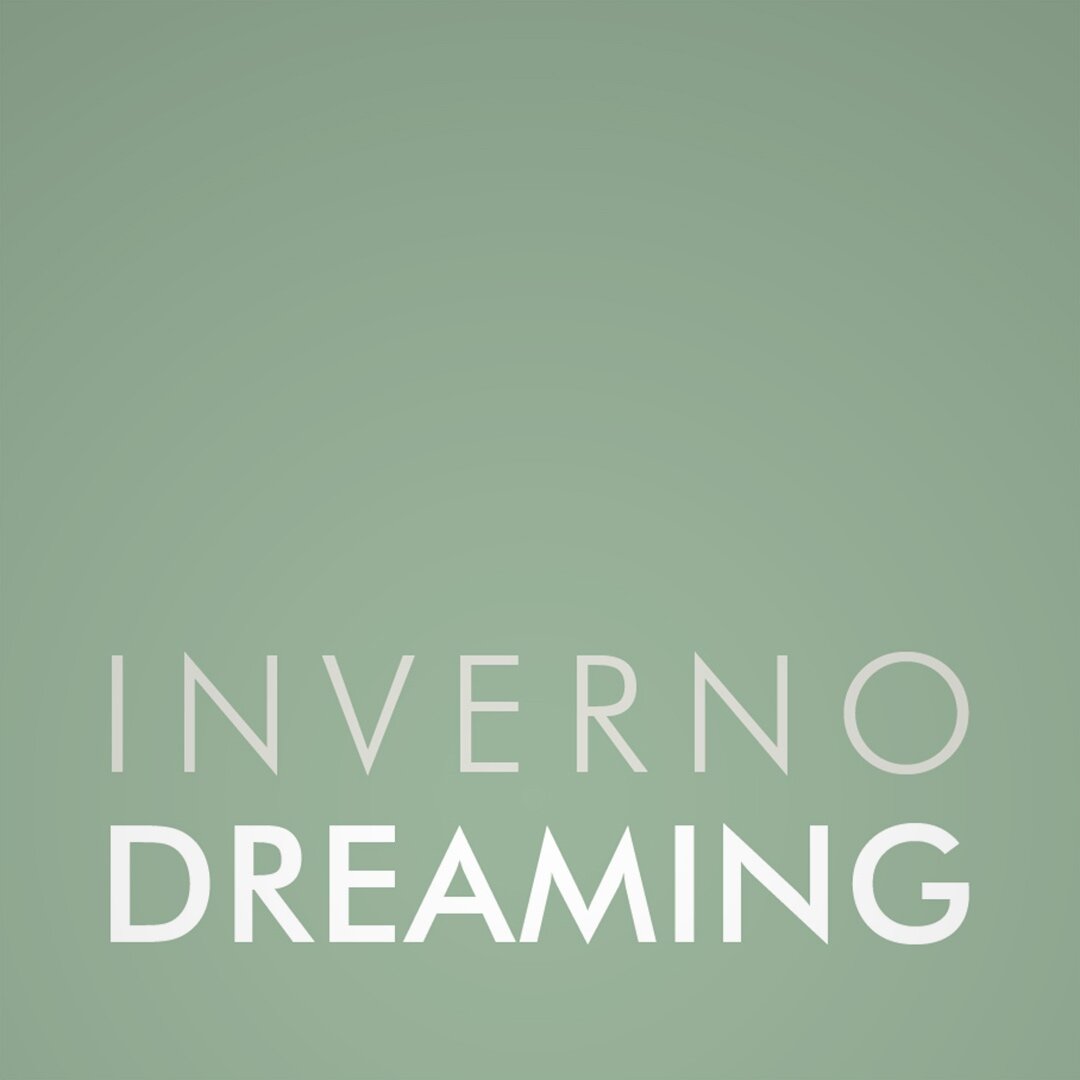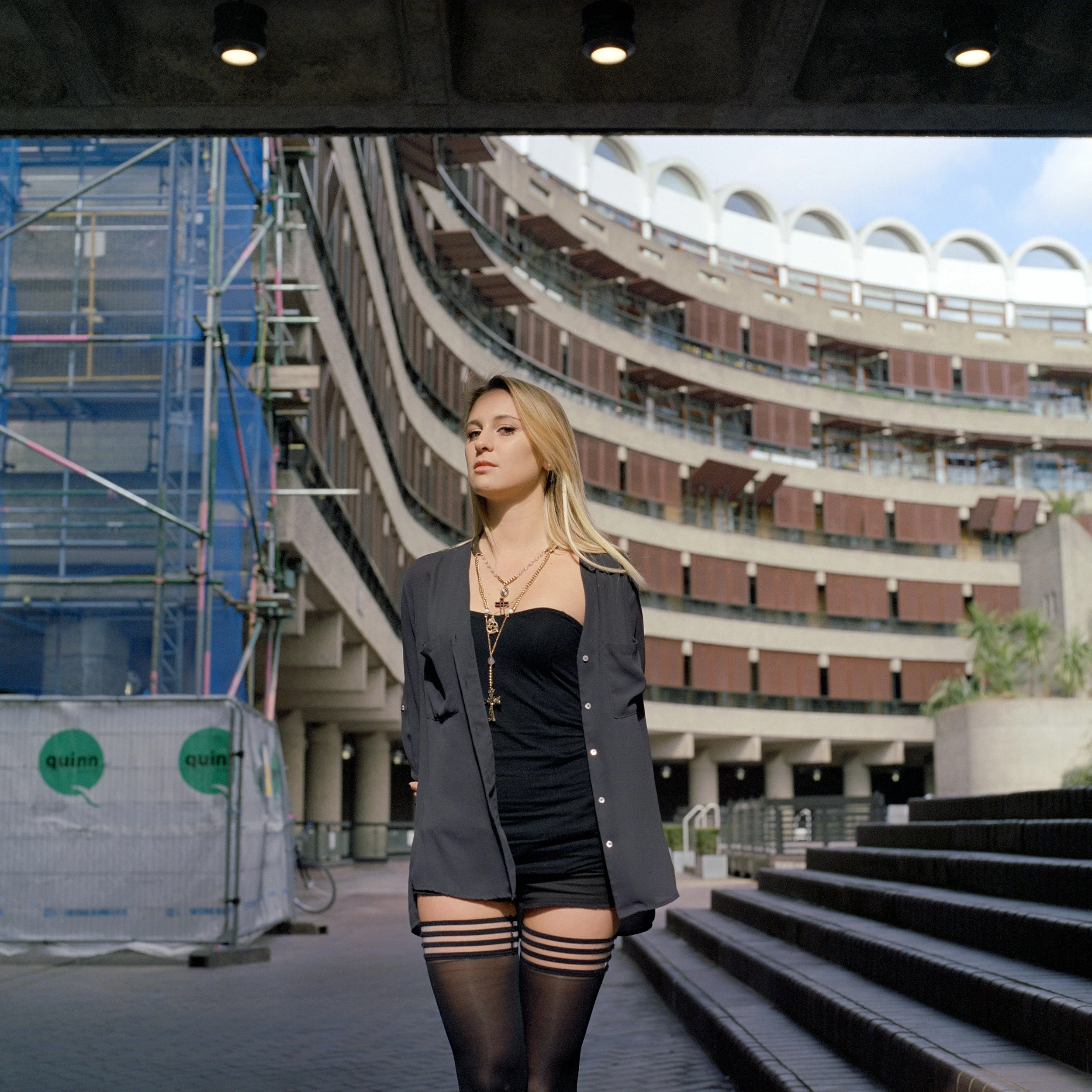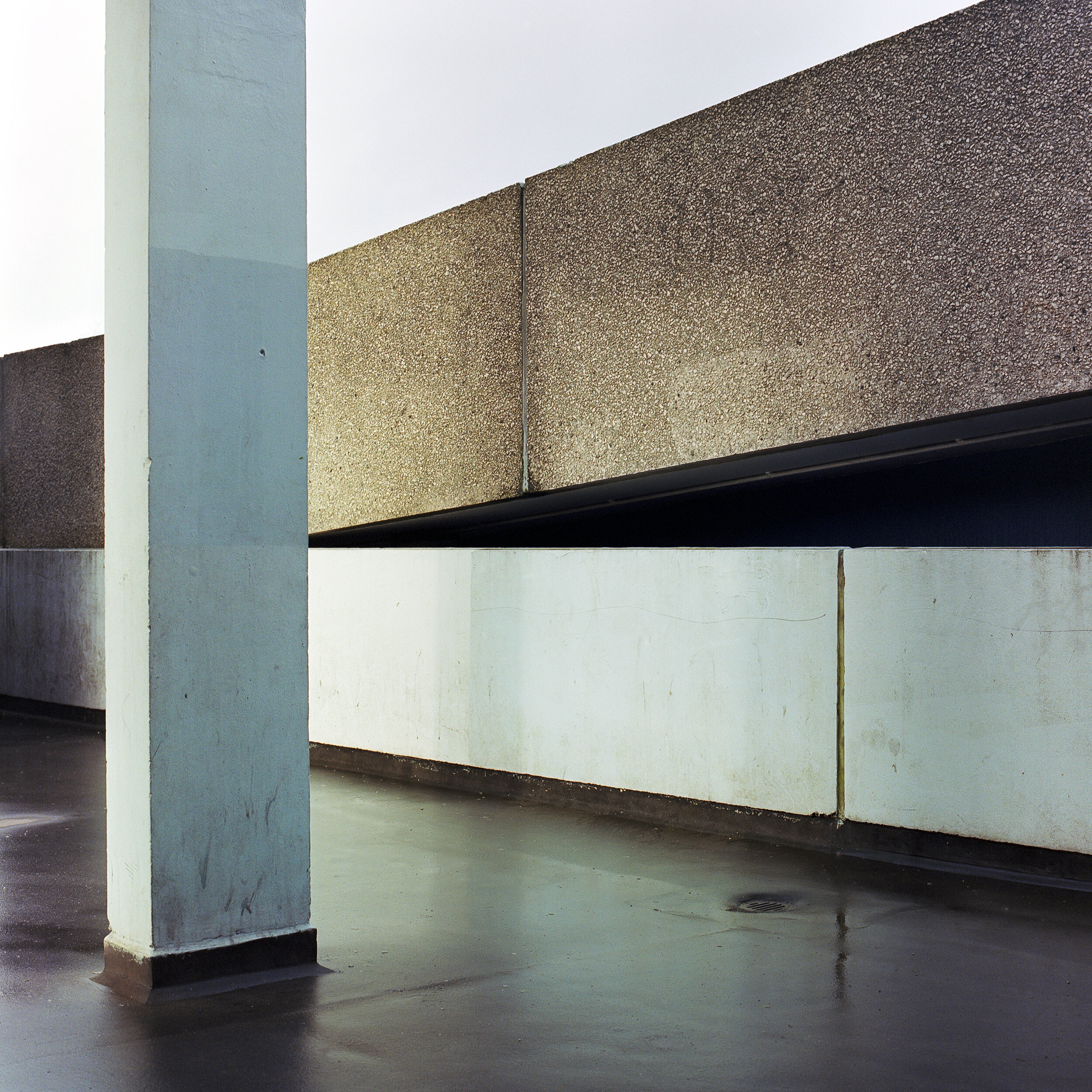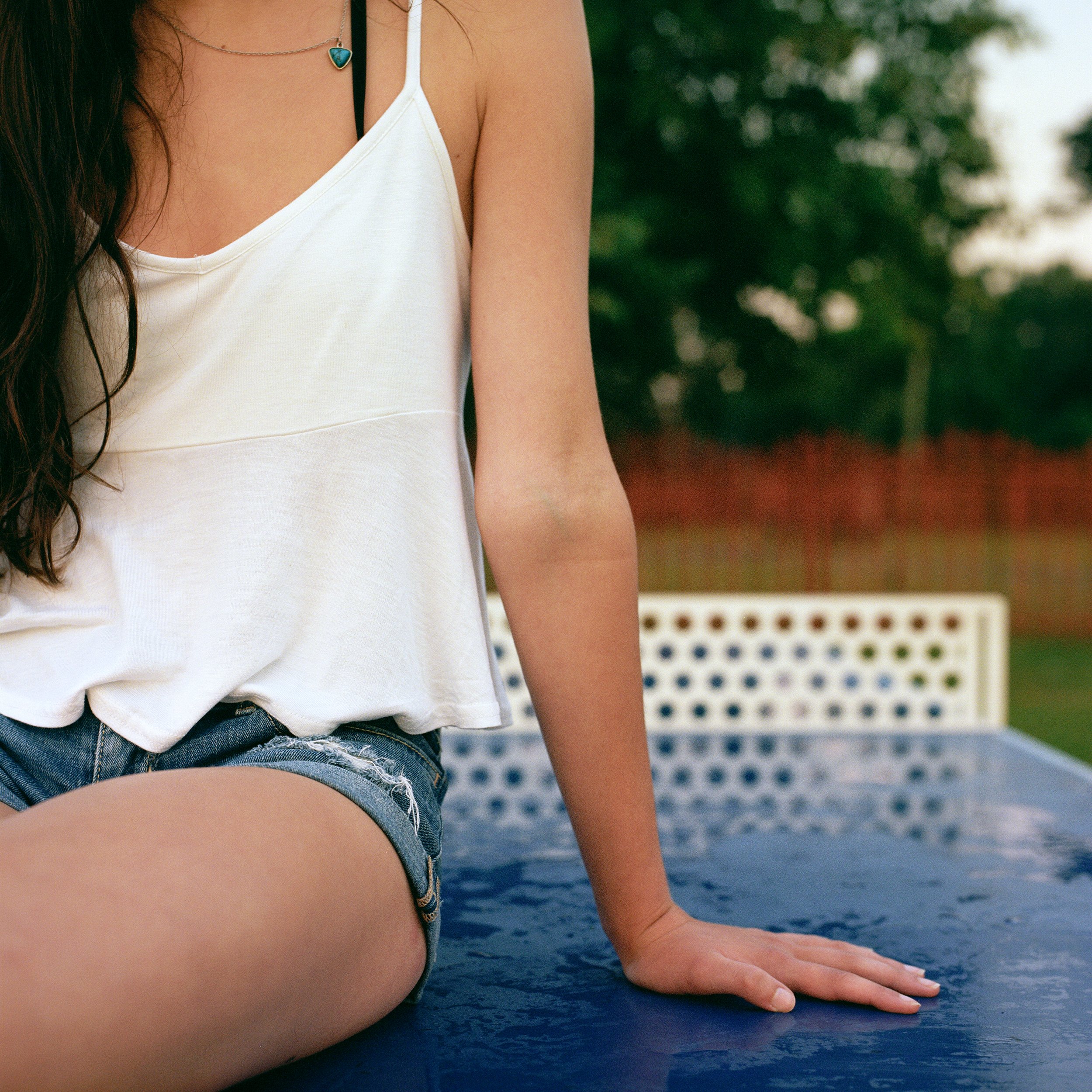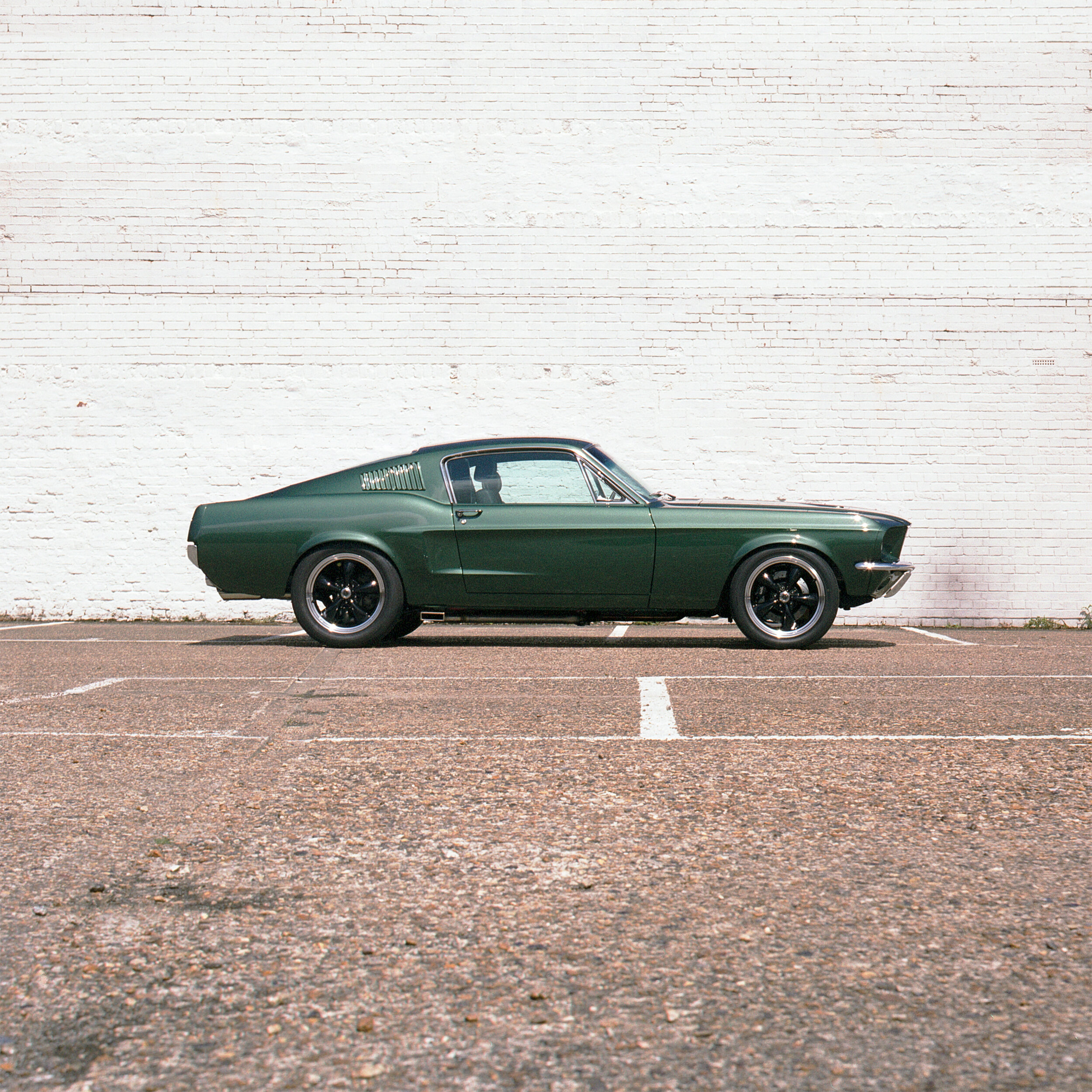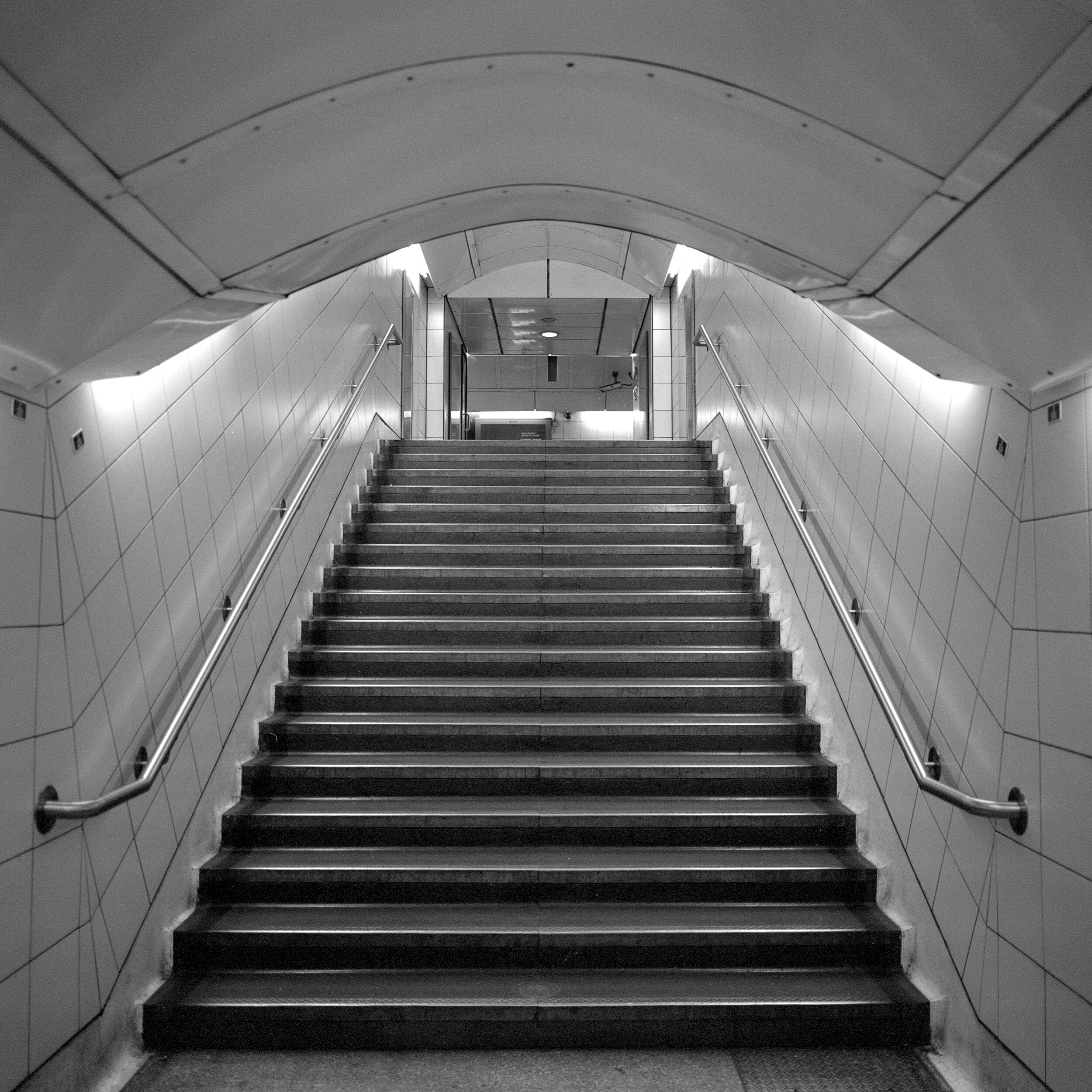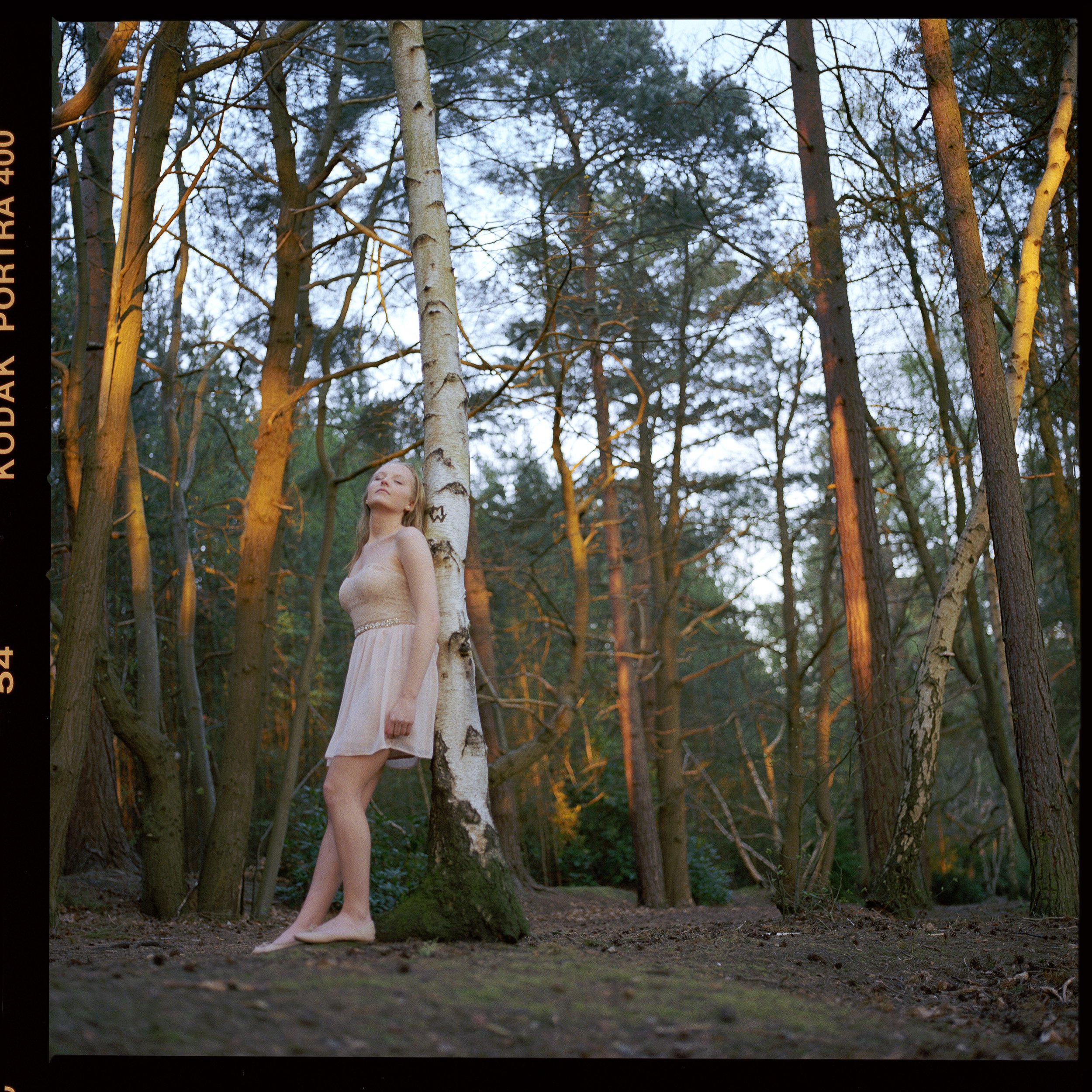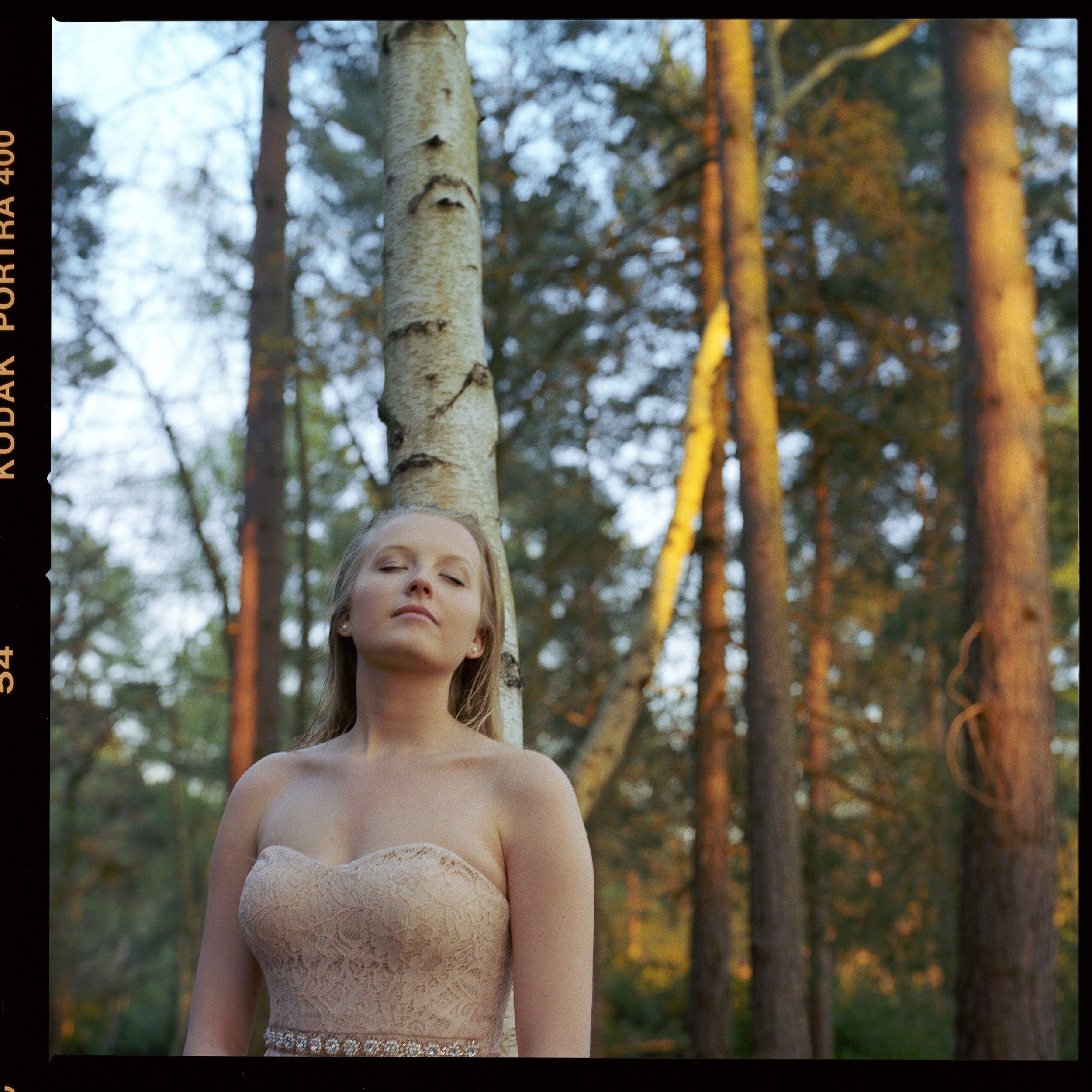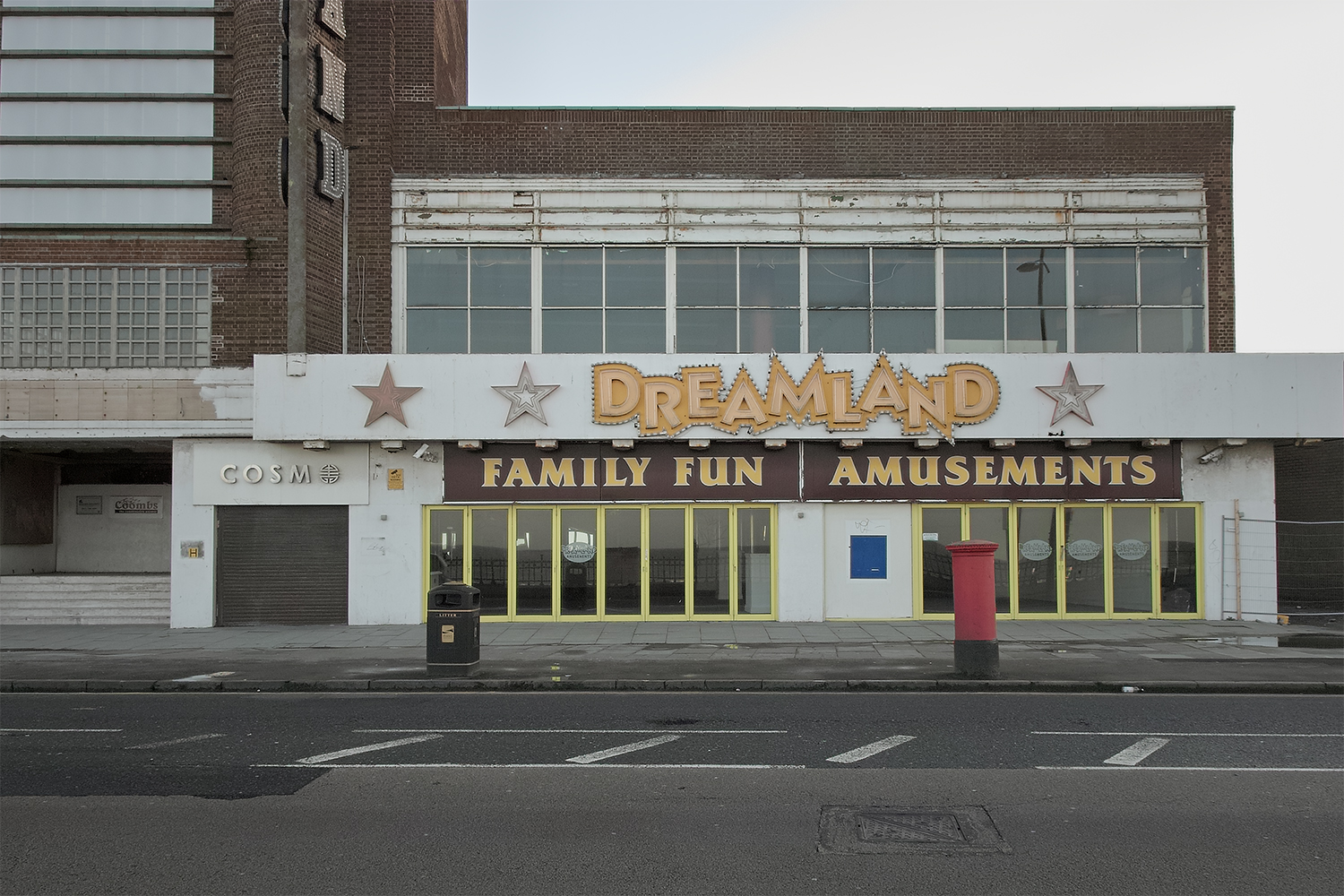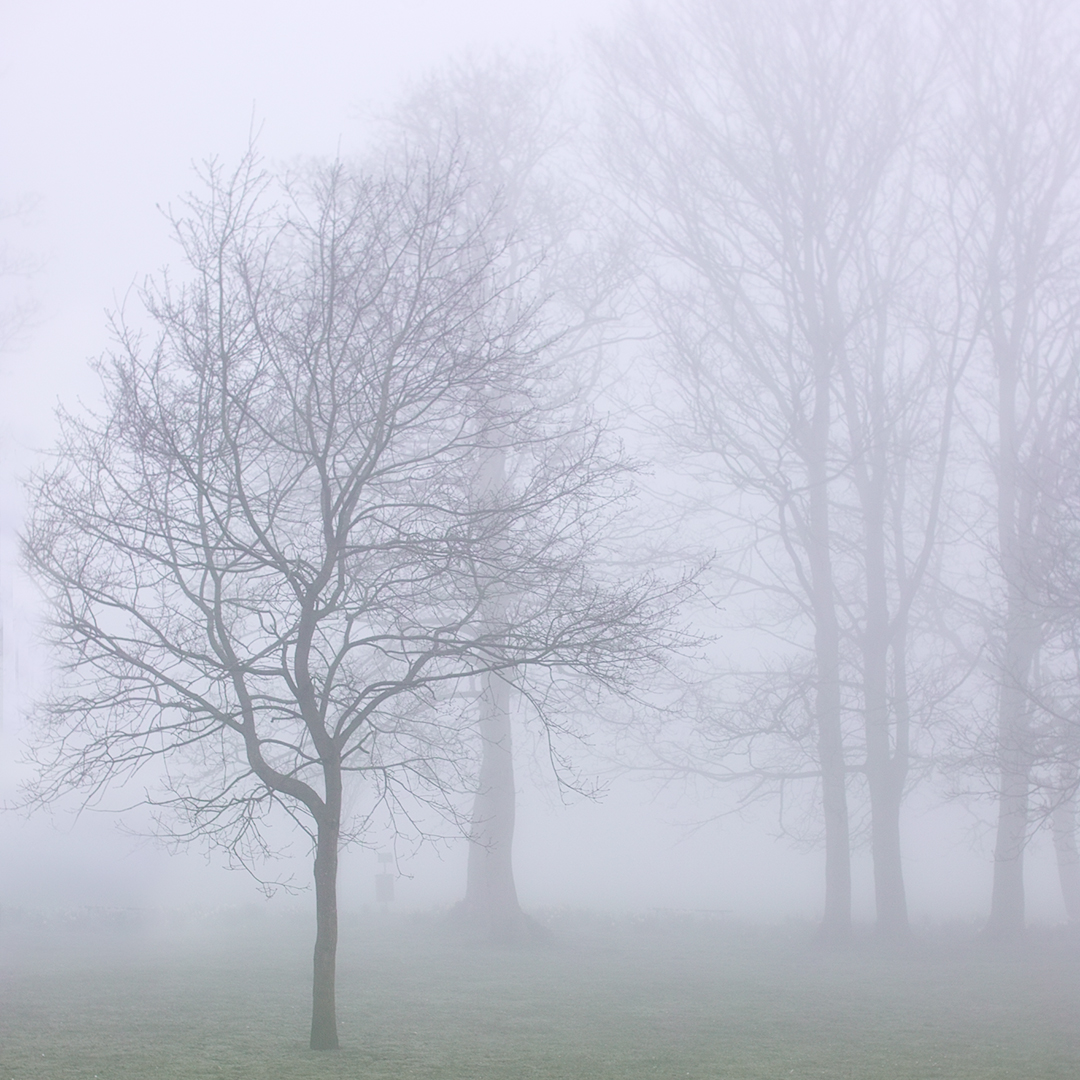All photographed with Hasselblad 500c/m on Fuji Pro 400H and Ilford HP5+ 400
Laundrette Semblance
The Frobisher Portraits
All photographed with Hasselblad 500c/m on Fuji Pro 400H and Kodak TMAX
Model: Sofia Cianciulli
Thamesmead
A couple of weekends back I met up with fellow photographer Andy Feltham for a wander around one of London’s largest 1960s housing estates, Thamesmead. I'm still trying to understand what attracts me as a photographer to this type of brutalist architecture. The buildings are often formed in geometric modular blocks linked together by skywalks and surrounded by parklands or in the case of Thamesmead, a large lake. I guess it's the mixture of forms that appeal to me along with the symmetrical lines and shapes. This together with the concrete! Concrete with its grey, raw and often unfinished surfaces cast into brave shapes, strong blocks and open expanses. On closer inspection surfaces reveal details of their casting method, impressions of wooden planks can often be seen, a tiny bit of natural interest on an otherwise unremitting manmade construction. All this mathematical design interacts with perspective and along with the texture and lines work with light and shadow which for me, almost create photographic compositions automatically.
I don’t necessarily see beauty in the style itself, in fact it appears to me that unless scrupulously maintained the surfaces are very prone to unsightly weathering, pollution and water staining. Constant cycles of hot and cold crack facades and rust streaking from the internal reenforcing bars mark walls and surfaces. However these details have their own photographic qualities and contrast strongly with the modernist and utopian ideals of their original designers.
While wondering around we met a guy from Leeds who's girlfriend was at a conference in London. He chose to spend his morning visiting Thamesmead! In conversation he asked if we were members of the Facebook group 'The Brutalism Appreciation Society' a group with over 30,000 members, so it looks like I'm certainly not alone in my attraction to brutalist architecture after all.
So High in Soho
by Rachel Donati
Wearing 140mm heels in always a vertiginous challenge. Finding your feet, your balance and your poise for a portrait is an even higher ask. So there we were, Tom and I, in London’s drizzling Soho watching the orange glow of raven black taxi lights bleed onto the patent wet cobbles; hunting out the acid neon light I am so addicted to for my portrait.
Naturally a little peacock-like I found it quite amusing trying to find space to hold still for Tom’s camera in the indigo night inside the gay rainbow streets of London. It’s not an easy task for Tom to find the right places for light levels or just a spot for us to squeeze into, whilst London sometimes saunters and sometimes rolls itself past.
Clattering girls, wrapped couples, strutting gayboys, drunken huddles; London’s streets has it all. And now it has us leaning into stripper’s signs in doorways the tart pink glowing in my eyes; slipping down alleyways under the guttering street lamps; tearing a muscle or two twisting in Madams’ forbidden doorways: all like Alice running down different roads with Tom the Mad Hatter taking the twists and turns.
The lights flick on and off as Tom shuts the camera lense; capturing the journey shutter by shutter. The challenge from the sitter’s perspective is that you have no safety net of an image to see. You’re committed to film in a moment and don’t know how you look or how the frame will sit. The moment is captured and you move on; you catch another and another and another. You have to trust Tom to tell you how to move yourself and where to look.
A quick heel change from YSL suede boots into beetle black Jimmy Choos and I sit on the stained steps in Charing Cross station. Strip lights that make you a little glue faced; the dirty floor littered with London’s trash; I think Tom likes to mix a little grime and grit into his images. Relieved to be sitting after two hours of walking and standing I look up and I think about some of the more troubling clouds in my mind. That’s the shot. It took a whole evening of persistence and tenacity but now there it is and remains. That moment captured.
Rachel Donati is a professional copywriter specialising in creative content and brand communication. I Shot Rachel with Kodak Portra 400 & Fuji Neopan 400 using a Hasselblad 500c/m
Sagrada Família
The moment I entered the beautiful interior of Barcelona's Sagrada Família I wanted to capture the ethereal light that threaded through the vaults 50 meters above my head. I shot half a roll of film in what stands as one of the world's most creative and unique churches. Designed by architect Antoni Gaudí (1852 - 1926) the unfinished basilica is rightly a UNESCO World Heritage site and a symbol of the Catalan capital.
All photographed with CONTAX S2 & Zeiss Distagon T* ƒ2.8 28mm using Fuji Neopan 400
Getting my hands wet
Just before Christmas I temporarily swapped cameras with my friend, he now has my square format Hasselblad 500c/m and I have taken in to care his beast of a Mamiya RZ67. I love to borrow and swap cameras, it's a chance to experience a different machine, feel and see what can be produced and well just try something else. The Mamiya is big and feels like a statement even before I take the lens cap off. Its 70 x 56mm negatives are also big, full of detail and easily the equal of what I'm used to in terms of image quality. For me, it's a refreshing change to have landscape and portrait available and in the case of the RZ67 via a nifty switch and revolving back, so there is no need to turn this monster of a camera on its side. But best of all I have three superb Mamiya Sekor lenses to play with, a wide 50mm, standard 90mm and portrait 127mm. It really is a great camera but be warned you'll need a battery and probably a tripod!
Moreover, I've finally bought some chemicals to develop my own black and white film and so now after a 29-year hiatus I getting my hands wet again. Back then I processed black and white film for a living. I worked in the darkest reaches of a lab where I spent most of the day sleeping and developing the odd roll of film, that was until 4 o'clock in the afternoon. The lab had a contract with the Racing Post, a daily newspaper dedicated to horse racing. Every day the sports photographers would drop off their day's films, anything between 30 and 50 rolls of the stuff and I only had two hours before they collected them again for the printers. And so I'm kind of an experienced novice! With tanks, thermometer and jugs in hand, I lost no time and so here are four photos from my first two rolls, well my first since 1986!
Redux
Two years ago my sister had a summer party, there wasn't much parking space outside her small cottage and what space there was taken up by a magnificent Buick Wildcat, all 18' of it! I lost no time finding the owner amongst the guests. Andy seemed quite unperturbed by my desire to photograph his car. The detailed explanation of my photographic methods, the use of medium format film and my love of cars, in general, was probably unnecessary as he agreed to meet up the next Sunday.
The following weekend during Andy's lunch break we met at the industrial estate where he worked. I didn't want to use all of his free time so I shot my roll of Ektar 100 fast. My final frame was a portrait of Andy in the driver's seat as he left. For me, this photo has a special significance, back then I sent my films to a lab for processing and scanning. One thing that had bugged me though was that often scans which came back from the lab were terrible. Being new to hybrid film/digital workflow I was never certain if it was bad scanning or my own camera work. In fact, it was that portrait of Andy which was the final straw, it came back from the lab as a totally unusable scan. Because I could see it's potential I inevitably felt compelled to finally purchase my own film scanner and learn to scan myself. I could not believe the difference between the lab scans and my own first effort, without any experience I managed a decent improvement; one that certainly left me with no regrets over my recent hardware purchase.
Two years later and quite a bit of scanning later too I have finally embarked on my redux project, that of scanning all of my old lab scanned negatives to see if I can extract any other presentable images. I started with Andy and the Buick Wildcat and if there is one thing I know now for sure is that "If you want something done properly, it's probably worth trying yourself"
Illuminating
20:30 on a late July evening, two photos only moments apart. Mary sat with her back to the setting sun; the numbers on the meter weren’t great! There was just enough light for one shot, before a compulsory move to the other side of the table. Now sat facing a rapidly setting sun the golden rays transformed the scene and at least gave me the light I needed.
There are many reasons why I like film anticipation is one. Between shooting and seeing the result my imagination has time to reflect on what might have been captured. In the days that pass while the film is at the lab I usually forget the details and as is often the case, but not always, it’s a pleasant surprise to see the results a couple of weeks later.
I have tried to build some sense of anticipation when I use my DSLR by not looking at the LCD screen, it may seem counter-intuitive, after all being able to check as you go along should be a good thing? But by resisting this temptation I learnt an even better thing. For me, constantly looking at the back of a camera is a habit that interferes with rhythm and distracts the connection between my subject and I. But worst than that ‘Chimping' undermines my own photographic instinct, it’s better to trust my own sense than a small screen, and in the end if I ever have a doubt I just look at my film negatives.
All photographed with Hasselblad 500c/m on Kodak Portra 400 film.
Assembly
With a roll of Ilford FP4+ 125 loaded in the CONTAX S2 and Zeiss Planar T* ƒ1.7 50mm mounted, I shot this short series with Sky. They were all taken in natural window light. I've never been much of an Ilford user, but I have to say that this film greatly impressed me especially as it expired in 2005!
Expired 1993
FUJICHROME VELVIA - 21 YEARS IN FOIL
A while ago my friend gave me her late father's old cameras and lenses. In the camera bag pocket were two rolls of expired Fuji Velvia 50. The boxes were covered in mildew. However, Fuji sealed their Velvia in thick foil wrappers and so even though they were 21 years out of date and been stored in the loft space above a garage, through many hot summers and cold winters, I figured it was worth shooting just to see what I got.
Velvia is a highly saturated daylight colour reversal film that's popular with nature and landscape photographers, both of which I'm not. But I do like portraiture so after shooting Izzy with some Kodak Portra 160, I thought why not try that old Velvia? she's got beautiful red hair and the meadow we were in was sort of a landscape!
The transparencies were a real surprise to me, they were so punchy and vivid, but in hindsight, that is to be expected from Fuji famous film. What I didn't expect is the beauty and robustness that emerged from such old and uncared for film. They did have a colour shift toward magenta, possibly due to age, that was reasonably corrected with post-processing. The overall final result suited my unorthodox experiment... using Velvia for portraits!
First Contact
Noel has been developing and printing his own work for over forty years and so as well as knowing a thing or two about photography he is an excellent teacher. I've been spending a bit of time in his darkroom and he has been encouraging me to take control of the ADOX! After developing the film, making the contact sheets was a great way to see how my latest shoot with Elizabeth unfolded and immediately which frames had potential.
Fuji Neopan 400 Contact Sheet
All photographed with CONTAX S2 & Zeiss Distagon T* ƒ2.8 28mm using Fuji Neopan 400 and expired TMAX 100.
Bullitt
Another test roll from the Flexaret VII, this beautiful Czechoslovakian TLR made by Meopta between 1966 - 1970, is an impressively solid machine. It's Belar ƒ3.5 80mm lens is really sharp and has a max 1/500 Pentacon Prestor shutter. Around the lens is a toothed ring, that locks the shutter speed and aperture together for EV type exposure. Focusing is done by means of a swinging anchor at the front of the camera. Other than that operation is pretty straightforward. My only reservation is the faint and dark focusing screen, this made composing the subject a lot harder than I'm used to.
In keeping with the age of the camera, I took some photos of one of Bill Shepherd's 60s classics, this superbly restored 68 Ford Mustang 390GT features modern brakes, suspension and power. It's all expertly restored to replicate the car driven by Steve McQueen in the 1968 film Bullitt. The iconic highland green car was used during one of the most memorable movie chase scenes ever shot.
All shot with Meopta Flexaret VII and expired Fujicolor NPS 160Pro
Down in a tube station...
A series of photos taken in and around the Elephant and Castle tube station and for me, inspired by Paul Weller’s Down in a Tube Station at Midnight. It was the second single taken from the album All Mod Cons by British band The Jam released in 1978.
All photographed with Mamiya 6 on Fuji Neopan 400 film.
Mercado De La Cebada
Mercado de la Cebada, La Latina, Madrid.
For me, walking around this indoor marketplace was a wonder. It felt as though the stalls were clinging for their commercial lives. Most of the viable traders were centred on the ground floor, closest to the street for convenient access; they still provide excellent meat, fresh fish, fruit & vegetables. On the upper floors and outer edges stood many unoccupied kiosks, lining the long corridors of shutters and patchy lighting. The building was almost like a time warp, its age was evident, but in many ways, I could see that it was a place held dear by its traders and the community it serves.
All photos taken with Sigma SD15 and Sigma EX ƒ1.4 30mm lens. Foveon RAW files processed with Sigma Photo Pro 5.5 and post processed with Adobe Photoshop CS6.
Quo Vadis, Baby?
All photographed with Hasselblad 500c/m on Fuji Neopan 400 & Kodak Portra 400 film.
Urban Maze
Like vital arteries, these access and service passages exist in every town and city. For me, they are a sort of backstage, an opposite to the often sparkling and gleaming front of house that they serve. Like multi-story car parks, warehouses and subways I find myself attracted by their unremarkable and ubiquitous nature. Maybe the challenge is to find some interest in these mundane but essential pieces of banal infrastructure.
All photographed at ƒ8 and ƒ11 with an exposure of 1 to 2 seconds. Shot with CONTAX S2 & Carl Zeiss Distagon T* ƒ2.8 28mm lens on Kodak Portra 400 film.
Dreamland
Margate, Kent
The area around All Saints Avenue with its brutalist 1960s tower Arlington House and its former seaside amusement park Dreamland offered a fascinating vision of how times change. The whole area patiently awaits renewal and so these images offer only a transient glimpse into their story.
All photos taken with Sigma SD15 and Sigma EX ƒ2.8 17-50mm lens. Foveon RAW files processed with Sigma Photo Pro 5.5 and post processed with Adobe Photoshop CS6.
Fogbound
Looking through the window a shroud of heavy fog blanked out the view. It was 6 am and I stood to think for a moment before I grabbed my camera... Spring will be here soon no time to lose.
All photos taken with Sigma SD15 and Sigma EX ƒ1.4 30mm lens. Foveon RAW files processed with Sigma Photo Pro 5.5 and post processed with Adobe Photoshop CS6.
Winter Pool
I regularly walk past this small park with its empty paddling pool and really like the turquoise colour and texture of its worn concrete surface. And so, on a cold Sunday afternoon with the light fading fast, Mary and I shot some frames on both Kodak Portra 400 and Fuji Neopan 400.
All photos were spot metered on CONTAX S2 and either ƒ2.8 or ƒ4 at 1/60 or 1/30.
